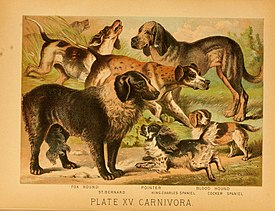User:Atsme/sandbox2TPUSA
A dog breed, or purebred dog in the modern sense, is not a kind or type of dog, but one that always breeds true to its specific phenotype, and its purpose or function. In order for a new breed to qualify as a bona fide breed, specific requirements must be met. A dog breed is not a type of dog; it must be a purebred. Official dog breed registries such as the American Kennel Club (AKC) or The Kennel Club (TKC) in the UK require proof that the foundation breeding stock used to create the breed were certified purebred dogs. In some cases, a DNA and genotype sample is required to demonstrate an acceptable DNA variation in the new breed.
To create a new breed, one must begin with a foundation of selective breeding stock that will emerge generations later with well-documented pedigrees, generations of breeding records, and an established breed standard developed and refined by reputable breeders and their respective parent clubs. Once the breed is proven to consistently breed true, an application is presented to one of the official breed registries the breed standard is presented to is considered the "blueprint" that judge's use to evaluate dogs in the show ring. true the propensity of a dog to perform specific tasks, such as herding, hunting, and guarding, as well as certain physical and mental attributes, although the latter is disputably characteristic of individual dogs rather than the entire breed, and is influenced more by environmental factors than genetics.
It wasn't until the Victorian era that purebred dogs became fashionable. Prior to that time, there was little to no documentation beyond anecdotal accounts of dog types that were named for their function.[1] No dog breed registries existed prior to the mid- to late-1800s. bred by humans to perform specific tasks, such as herding, hunting, and guarding. Dogs are the most variable mammal on earth, with artificial selection producing around 450 globally recognized breeds. These breeds possess distinct traits related to morphology, which include body size, skull shape, tail phenotype, fur type, body shape, and coat colour. Their behavioural traits include guarding, herding, and hunting, and personality traits such as hypersocial behavior, boldness, and aggression. Most breeds were derived from small numbers of founders within the last 200 years. As a result, today dogs are the most abundant carnivore species and are dispersed around the world.[2]
A dog breed will consistently produce the physical traits, movement and temperament that were developed over decades of selective breeding. For each breed they recognize, kennel clubs and breed registries usually maintain and publish a breed standard which is a written description of the ideal specimen of the breed.[3][4][5] Other uses of the term breed when referring to dogs include pure breeds, cross-breeds, mixed breeds and natural breeds.[6]
Prior to the standardisation of dog breeds, there were different types of dogs that were defined by their function. Many different terms were used to describe dogs, such as breed, strain, type, kind, and variety. By the end of the Victorian era, society had changed and so did the role of dogs. Form was given a more prominent role than function.[7] Different types or breeds of dog were being developed by breeders who wanted to define specific characteristics and desirable features in their dogs. Driven by dog shows and the groups that hosted them, the term dog breed took on an entirely new meaning. Dog show competitions included best-in-breed winners, and the purebreds were winning.[7] Breed standards are the reason the breed came to be, and with those standards are key features, including form, function and fitness for purpose. The Kennel Club in the UK was founded in 1873, and was the world's first national kennel club and breed registry.[8] The International Canine Federation was founded in 1911 as a worldwide organisation. Its objective is to bring global uniformity to the breeding, exhibiting and judging of pure-bred dogs. It now has 99 members countries.

- ^ Harris, David (2008). Bully breeds. Freehold, NJ: Kennel Club Books. p. 14. ISBN 978-1-59378-664-9. OCLC 172980066.
- ^ Cite error: The named reference
Ostrander2019was invoked but never defined (see the help page). - ^ "Dog Breeds - Types Of Dogs". American Kennel Club. 2017-11-12. Retrieved 2019-08-08.
- ^ Irion, D (2003). "Analysis of Genetic Variation in 28 Dog Breed Populations With 100 Microsatellite Markers". Journal of Heredity. 94 (1): 81–7. doi:10.1093/jhered/esg004. PMID 12692167.
- ^ "About Breed Standards". Home. Retrieved 2019-08-09.
- ^ "Dog Breed Profiles". Dog Breed Profiles. Retrieved 2020-02-29.
- ^ a b Worboys, Michael (2019-04-13). "The history of dog breeds". The Week. Retrieved 2019-08-08.
- ^ "History of the Kennel Club". Home. Retrieved 2019-08-09.
